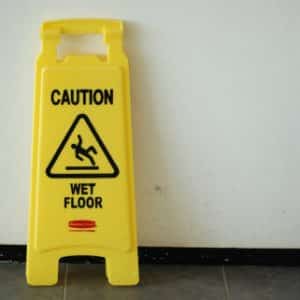We would all like to think that when we give our hard earned money to a landlord every month that they will do everything they can to make sure that the building we live in is safe. In fact, the Occupational Safety & Health Administration and the Department of Buildings provides contractors and building owners with a life of building codes that must be met in order to keep residents and visitors safe from harm. The problem is, that many are too concerned with saving time and money to follow these codes.
Visit related articles: https://banvillelaw.com/slip-fall-accidents/apartment-condo/
All apartment buildings have staircases and as surprising as it may be, these structures can be incredibly dangerous if not well maintained or properly built. A 33-year-old man found that out the 
One afternoon when descending the front staircase of his apartment building, he became the victim of a slip & fall accident. Just prior to his fall, a contractor had waxed the floor creating a slippery surface. When his foot came in contact with the wax, he fell down several stairs.
He became immediately aware that he had injured himself and was rushed to the emergency room with pain in his right hip and knee. The doctors in the ER performed an examination and x-rays but didn’t immediately find anything wrong. It wasn’t until he returned to his doctor a few days later, still in pain, that he was found to have multiple herniated disks and a tear in his right meniscus.
He spent the next several months doing the recommended physical therapy, however, ultimately due to a lack of progression, his doctors decided that surgery was the best treatment. He had a discectomy and fusion of C5-6, as well as an arthroscopic repair of the torn muscle in his knee. Despite this treatment, he still has pain and a limited range of motion. He has been unable to return to his job in a retail store. His past medical expenses were more than $90,000 and he is expected to need future treatments.
The victim filed complaints against three parties:
He alleged that the waxed floors were a hazard, that there were no caution signs placed around the waxed area, and that there was a lack of a center handrail on the stairs, which could have helped him to prevent the fall.
In response, the defendants claimed that his damaged vertebra were from a previous car accident. They also stated that there was no evidence that he would need future medical care for any of his injuries.
The case never made it to trial as both parties were able to agree on a settlement during the pretrial mediation, providing the plaintiff with $1.75 million in compensation.

Frequently, before taking a case to trial, the parties involved in a lawsuit work with a neutral third party to resolve the case. Each party is given the opportunity to make an uninterrupted statement, telling their side of the story and then they will be asked questions by the mediator. Then, both sides can work through the mediator to negotiate an agreement that satisfied both sides.
Mediation is optional and it doesn’t usually focus on who is “right” or “wrong” but instead looks at how the dispute can be best resolved. If a common ground can’t be reached, then the case may still go to trial.
While it’s never possible to determine exactly how much a case it worth, when determining an award or settlement, several main factors are always taken into consideration:
It is extremely important that you seek medical attention as soon as possible and that you request copies of all of your medical records. These records are some of the most important evidence that will be presented and vague or incomplete records can not only seriously damage a claim, but can compromise the plaintiff’s future medical care.
Also see: Five Common Injuries Suffered in Premises Liability Accidents